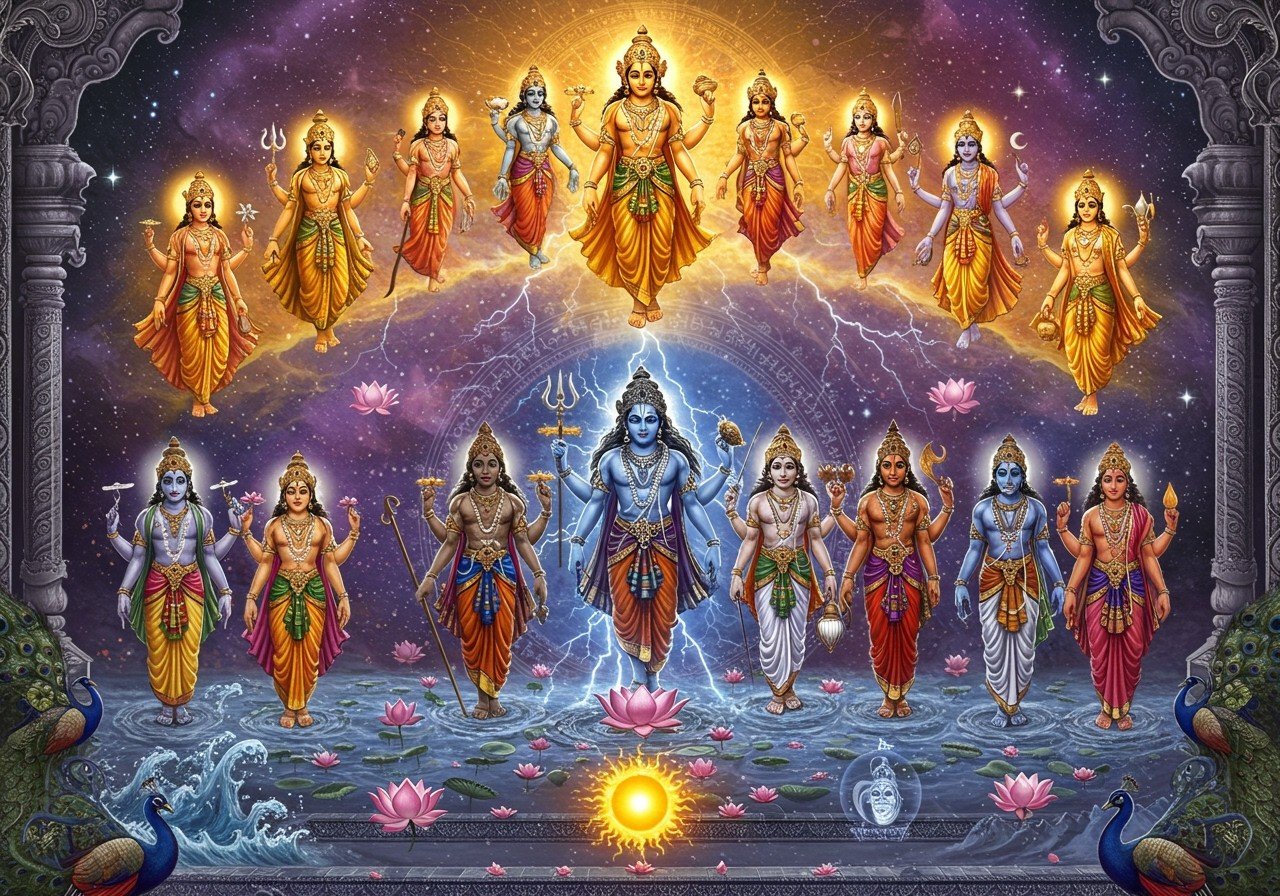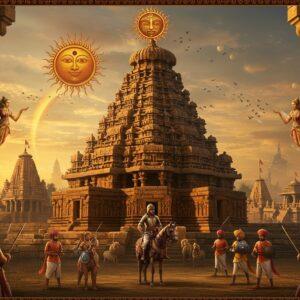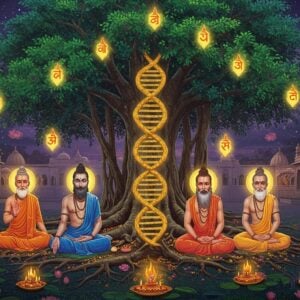
In the vast tapestry of Hindu cosmology, the Vedic Pantheon stands as a cornerstone of spiritual belief. The Adityas, Rudras, and Vasus play crucial roles in shaping traditions and practices. These deities are deeply embedded in the lives of many Indians who value cultural heritage and seek authentic ritual items online. Understanding these gods offers a glimpse into the rich structure and hierarchy of divine entities that have influenced generations. For individuals seeking to deepen their understanding of Hindu beliefs, resources like Exploring Hinduism: Core Beliefs and Practices and Hindu Gods and Goddesses: A Complete Guide can be invaluable.
The Adityas: Guardians of Cosmic Order
The Adityas are solar deities found in Vedic texts, representing order in the universe. These twelve deities, including Varuna, god of water and cosmic order, and Mitra, associated with friendship and agreements, uphold Rta, the righteous cosmic law. Their connection with Surya, the Sun God, underscores their solar nature. The Adityas continue to be revered in modern Hindu practices and have profoundly influenced Hindu mythology.
The Rudras: Harbingers of Transformation
The Rudras are complex deities, eleven in number, associated with storms, change, and sometimes, healing. They embody both benevolent and fierce aspects, perfectly exemplified by Rudra-Shiva. In Vedic rituals, they are appeased to harness their transformative energy and mitigate potential wrath. Over time, reverence for the Rudras evolved into the widespread worship of Lord Shiva. Their iconography and symbolism remain culturally significant.
The Vasus: Embodiments of Natural Elements
The Vasus are eight deities symbolizing essential natural forces like fire (Agni), water (Apa), and air (Vayu). They play a vital role in maintaining equilibrium during Vedic sacrifices. A well-known narrative of their curse and subsequent redemption underscores their impact on Hindu mythology. The Vasus are invoked for prosperity, protection, and are often depicted in art and literature, showcasing their enduring legacy.
Interconnections and Differentiations
The Adityas, Rudras, and Vasus constitute a dynamic triad within the Vedic pantheon. Their roles complement and contrast, offering valuable insights into the nuances of Vedic spirituality. Themes of protection (Adityas), transformation (Rudras), and harmony (Vasus) intertwine within their narratives. Scholarly debates and diverse interpretations of their roles reflect the intricate worldview of ancient India, with its emphasis on interconnected cosmic forces. For a deeper dive into Hindu rituals and their significance, you can explore Hindu Rituals: Significance and Importance.
Cultural Impact and Modern Relevance
The Vedic pantheon, including the Adityas, Rudras, and Vasus, has deeply influenced Hindu traditions and continues to hold relevance in contemporary practices. Their stories offer guidance on navigating life’s complexities. Explore the significance of Hindu temples with our guide: Hindu Temples Explained: A Guide to Their Significance.
Adityas: Celebrated through festivals like Makar Sankranti, honoring Surya, the Sun God. Devotees seek blessings for prosperity and good fortune, often with offerings and prayers invoking these powerful solar deities. Poojn.in offers a range of products perfect for such observances, including camphor and incense sticks.
Rudras: Their association with transformation resonates with personal growth. Devotees turn to Rudra-Shiva during challenging times, seeking strength and renewal. Maha Shivaratri, a major festival dedicated to Shiva, involves night-long vigils and prayers. For those looking to create a sacred space for worship, our guide on creating a personal puja altar can be very helpful. Enhance your devotion with beautiful Shiva lingams available on Poojn.in.
Vasus: Representing natural elements, the Vasus inspire reverence for the environment. Their role in Vedic sacrifices highlights the importance of ecological balance. Modern practitioners invoke them for protection and abundance. Discover a wide selection of brass and copper kalash, ideal for Vasu worship, at Poojn.in.
The Vedic pantheon’s influence extends to Indian philosophy, literature, and the arts. Ancient texts like the Rigveda contain hymns dedicated to these deities, while their iconography features prominently in temples and sculptures. Poojn.in makes it convenient to connect with tradition by offering authentic ritual items online. This bridges the gap between modern living and ancient practices, empowering individuals to honor their heritage. Learning more about these deities enriches one’s spiritual understanding, offering wisdom and guidance relevant for contemporary life. Discover more about the power and purpose of mantras in daily life with our informative post: Mantras: Their Power and Purpose in Daily Life.
Hindu Deities: A Broader Perspective
Hinduism encompasses a diverse range of gods and goddesses, with followers embracing various perspectives, including polytheism, pantheism, monotheism, monism, and even agnosticism, atheism, or humanism. Deities are referred to by various terms like Deva, Devi, Ishvara, Ishvari, Bhagavan, and Bhagavati.
- Brahman: Hindus believe in a supreme, all-pervading God force called Brahman. All gods and goddesses are considered manifestations of this single, ultimate reality. This concept of Brahman is central to understanding the interconnectedness of the divine.
- The Trimurti: This “triple form” comprises Brahma (the Creator), Vishnu (the Preserver), and Shiva (the Destroyer or Transformer). This triad explains the cyclical nature of creation, preservation, and destruction/transformation in the universe.
- Brahma, consort of Saraswati (goddess of learning), is responsible for creating the world and all life forms.
- Vishnu, consort of Lakshmi (goddess of wealth and prosperity), preserves and protects the universe, upholding Dharma (cosmic order).
- Shiva, consort of Parvati (also worshipped as Durga and Kali), destroys to recreate, embodying transformation and the cyclical nature of time.
- Devi: In Shaktism, the goddess Shakti (Devi) is revered as the supreme deity, embodying divine feminine power. She is often depicted as fighting to restore dharma.
- Parvati symbolizes love, devotion, and fertility. She is an essential aspect of Devi, representing the nurturing and compassionate aspects of the divine feminine.
- Lakshmi embodies wealth, fortune, power, luxury, beauty, fertility, and auspiciousness. Her presence is invoked for prosperity and abundance.
- Saraswati is associated with knowledge, music, art, creativity, and wisdom. She is revered as the source of inspiration and learning.
- Durga, a powerful manifestation of Devi, embodies the combined might of all Hindu gods. She is often depicted as a warrior goddess, vanquishing evil and protecting the righteous.
- Kali represents time, change, and the transformative power of the universe. She is often portrayed as a fierce goddess, but her energy is ultimately one of liberation and renewal.
- Other Gods: The Hindu pantheon includes numerous other deities, each with unique roles and attributes.
- Krishna is revered as the god of compassion, tenderness, and love. His stories and teachings emphasize devotion and selfless action.
- Ganesh, widely worshipped, especially in western India, is invoked for new beginnings and the removal of obstacles.
- Hanuman, revered for his strength, devotion, and loyalty to Lord Rama, is worshipped as a symbol of perseverance and service.
Different regions have their preferred deities, and personal needs often influence individual choices of worship. While the pantheon is vast, many Hindus believe in one supreme God, viewing the various gods and goddesses as different facets of the same divine reality. To delve deeper into Hindu fasting traditions, explore our dedicated blog post: Hindu Fasting: Purpose, Practices, and Significance. If you’re interested in learning more about Ganesh Chaturthi celebrations, be sure to read our guide on Ganesh Chaturthi: Celebration, Rituals, and Traditions Explained. And for those wishing to understand temple etiquette and rituals, we offer a comprehensive guide: Temple Etiquette and Rituals: A Guide to Exploring the Divine.
Poojn.in, India’s largest cultural goods and services store, offers a wide array of products to support your devotional practices. Visit our website www.poojn.in to explore our collection. We provide everything you need, from murtis and puja accessories to sacred texts and more. Laddoo Gopal Murtis, Radha Krishna Murtis, and more are readily available. Embrace the divine with authentic and high-quality products from Poojn.in. Browse our extensive selection today!


